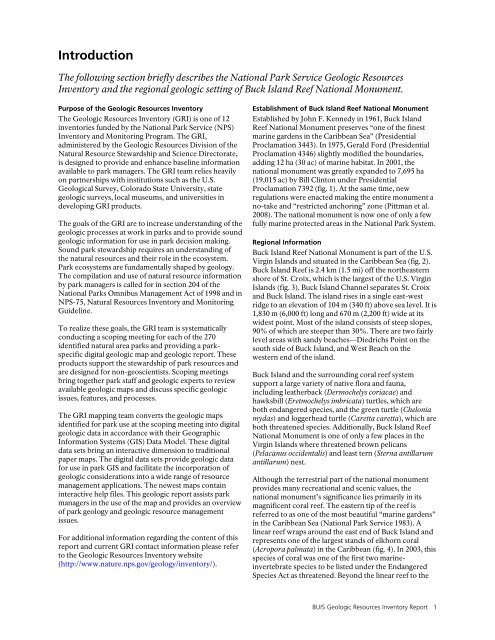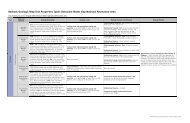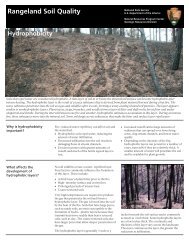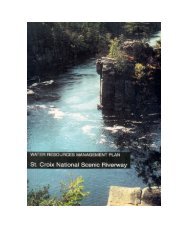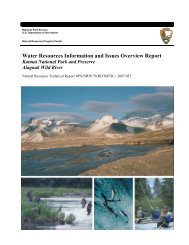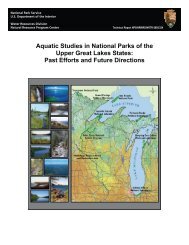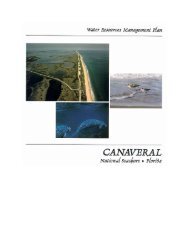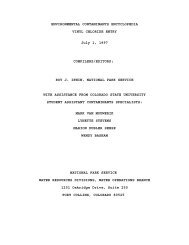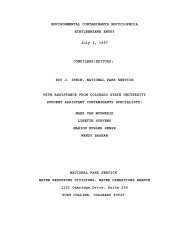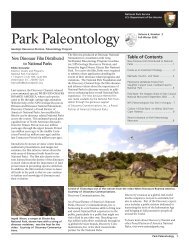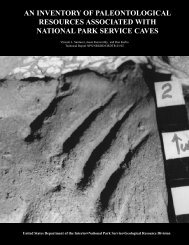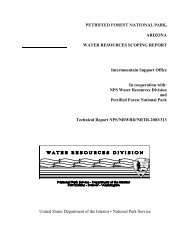Buck Island Reef National Monument Geologic Resources Inventory
Buck Island Reef National Monument Geologic Resources Inventory
Buck Island Reef National Monument Geologic Resources Inventory
Create successful ePaper yourself
Turn your PDF publications into a flip-book with our unique Google optimized e-Paper software.
Introduction<br />
The following section briefly describes the <strong>National</strong> Park Service <strong>Geologic</strong> <strong>Resources</strong><br />
<strong>Inventory</strong> and the regional geologic setting of <strong>Buck</strong> <strong>Island</strong> <strong>Reef</strong> <strong>National</strong> <strong>Monument</strong>.<br />
Purpose of the <strong>Geologic</strong> <strong>Resources</strong> <strong>Inventory</strong><br />
The <strong>Geologic</strong> <strong>Resources</strong> <strong>Inventory</strong> (GRI) is one of 12<br />
inventories funded by the <strong>National</strong> Park Service (NPS)<br />
<strong>Inventory</strong> and Monitoring Program. The GRI,<br />
administered by the <strong>Geologic</strong> <strong>Resources</strong> Division of the<br />
Natural Resource Stewardship and Science Directorate,<br />
is designed to provide and enhance baseline information<br />
available to park managers. The GRI team relies heavily<br />
on partnerships with institutions such as the U.S.<br />
<strong>Geologic</strong>al Survey, Colorado State University, state<br />
geologic surveys, local museums, and universities in<br />
developing GRI products.<br />
The goals of the GRI are to increase understanding of the<br />
geologic processes at work in parks and to provide sound<br />
geologic information for use in park decision making.<br />
Sound park stewardship requires an understanding of<br />
the natural resources and their role in the ecosystem.<br />
Park ecosystems are fundamentally shaped by geology.<br />
The compilation and use of natural resource information<br />
by park managers is called for in section 204 of the<br />
<strong>National</strong> Parks Omnibus Management Act of 1998 and in<br />
NPS-75, Natural <strong>Resources</strong> <strong>Inventory</strong> and Monitoring<br />
Guideline.<br />
To realize these goals, the GRI team is systematically<br />
conducting a scoping meeting for each of the 270<br />
identified natural area parks and providing a parkspecific<br />
digital geologic map and geologic report. These<br />
products support the stewardship of park resources and<br />
are designed for non-geoscientists. Scoping meetings<br />
bring together park staff and geologic experts to review<br />
available geologic maps and discuss specific geologic<br />
issues, features, and processes.<br />
The GRI mapping team converts the geologic maps<br />
identified for park use at the scoping meeting into digital<br />
geologic data in accordance with their Geographic<br />
Information Systems (GIS) Data Model. These digital<br />
data sets bring an interactive dimension to traditional<br />
paper maps. The digital data sets provide geologic data<br />
for use in park GIS and facilitate the incorporation of<br />
geologic considerations into a wide range of resource<br />
management applications. The newest maps contain<br />
interactive help files. This geologic report assists park<br />
managers in the use of the map and provides an overview<br />
of park geology and geologic resource management<br />
issues.<br />
For additional information regarding the content of this<br />
report and current GRI contact information please refer<br />
to the <strong>Geologic</strong> <strong>Resources</strong> <strong>Inventory</strong> website<br />
(http://www.nature.nps.gov/geology/inventory/).<br />
Establishment of <strong>Buck</strong> <strong>Island</strong> <strong>Reef</strong> <strong>National</strong> <strong>Monument</strong><br />
Established by John F. Kennedy in 1961, <strong>Buck</strong> <strong>Island</strong><br />
<strong>Reef</strong> <strong>National</strong> <strong>Monument</strong> preserves “one of the finest<br />
marine gardens in the Caribbean Sea” (Presidential<br />
Proclamation 3443). In 1975, Gerald Ford (Presidential<br />
Proclamation 4346) slightly modified the boundaries,<br />
adding 12 ha (30 ac) of marine habitat. In 2001, the<br />
national monument was greatly expanded to 7,695 ha<br />
(19,015 ac) by Bill Clinton under Presidential<br />
Proclamation 7392 (fig. 1). At the same time, new<br />
regulations were enacted making the entire monument a<br />
no-take and “restricted anchoring” zone (Pittman et al.<br />
2008). The national monument is now one of only a few<br />
fully marine protected areas in the <strong>National</strong> Park System.<br />
Regional Information<br />
<strong>Buck</strong> <strong>Island</strong> <strong>Reef</strong> <strong>National</strong> <strong>Monument</strong> is part of the U.S.<br />
Virgin <strong>Island</strong>s and situated in the Caribbean Sea (fig. 2).<br />
<strong>Buck</strong> <strong>Island</strong> <strong>Reef</strong> is 2.4 km (1.5 mi) off the northeastern<br />
shore of St. Croix, which is the largest of the U.S. Virgin<br />
<strong>Island</strong>s (fig. 3). <strong>Buck</strong> <strong>Island</strong> Channel separates St. Croix<br />
and <strong>Buck</strong> <strong>Island</strong>. The island rises in a single east-west<br />
ridge to an elevation of 104 m (340 ft) above sea level. It is<br />
1,830 m (6,000 ft) long and 670 m (2,200 ft) wide at its<br />
widest point. Most of the island consists of steep slopes,<br />
90% of which are steeper than 30%. There are two fairly<br />
level areas with sandy beaches—Diedrichs Point on the<br />
south side of <strong>Buck</strong> <strong>Island</strong>, and West Beach on the<br />
western end of the island.<br />
<strong>Buck</strong> <strong>Island</strong> and the surrounding coral reef system<br />
support a large variety of native flora and fauna,<br />
including leatherback (Dermochelys coriacae) and<br />
hawksbill (Eretmochelys imbricata) turtles, which are<br />
both endangered species, and the green turtle (Chelonia<br />
mydas) and loggerhead turtle (Caretta caretta), which are<br />
both threatened species. Additionally, <strong>Buck</strong> <strong>Island</strong> <strong>Reef</strong><br />
<strong>National</strong> <strong>Monument</strong> is one of only a few places in the<br />
Virgin <strong>Island</strong>s where threatened brown pelicans<br />
(Pelacanus occidentalis) and least tern (Sterna antillarum<br />
antillarum) nest.<br />
Although the terrestrial part of the national monument<br />
provides many recreational and scenic values, the<br />
national monument’s significance lies primarily in its<br />
magnificent coral reef. The eastern tip of the reef is<br />
referred to as one of the most beautiful “marine gardens”<br />
in the Caribbean Sea (<strong>National</strong> Park Service 1983). A<br />
linear reef wraps around the east end of <strong>Buck</strong> <strong>Island</strong> and<br />
represents one of the largest stands of elkhorn coral<br />
(Acropora palmata) in the Caribbean (fig. 4). In 2003, this<br />
species of coral was one of the first two marineinvertebrate<br />
species to be listed under the Endangered<br />
Species Act as threatened. Beyond the linear reef to the<br />
BUIS <strong>Geologic</strong> <strong>Resources</strong> <strong>Inventory</strong> Report 1


